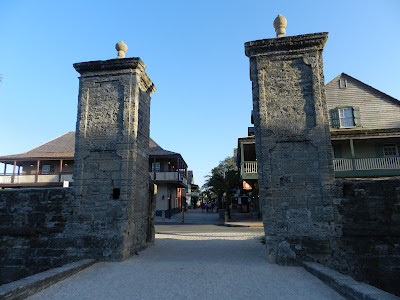Sunday, April 29, 2012
Getting Beyond St. Augustine
Perhaps my present journey or maybe every remaining day of my life has something to do with looking for the Fountain of Youth. Therefore I found it apropos that I was now in St.Augustine, the oldest city on the continent, which is mistakenly associated with Ponce de Leon's search for the waters of eternal life. DeLeon had been killed by a poison arrow in Cuba in 1521 and the myth about him started long before St.Augustine had been founded in 1565. I stood at the entrance of Fountain of Youth Park, the grounds of the first settlement where Spaniards began christianizing Natives. A peek through the wrought-iron fence showed me that the ancient village appeared to have been transformed into a theatrical tourist attraction. I peeked through the wrought iron fence and decided that I would not step through these gates of history but would rather stroll carefree along the waterfront and walk through the narrow streets of the renowned old city.
I parked several blocks away in a neighborhood of stately turn-of-the-century houses adjacent the campus of Flagler University which consisted of some of the most glorious gothic-style buildings and churches I had seen since I had been to Europe. According to a brochure and map a hotel clerk had thrust in my hand along with a coupon for a discount at some eatery, I had to find a lane which was purported to be lined with authentic buildings dating from the 17th Century. I turned a corner from an alley and found myself on a cobblestone path and was practically swept up by a throng of bodies in gawdy shorts, designer tank tops and t-shirts which touted the importance of various towns and colleges. On both sides of this pedestrian mall, in replicated buildings mimicking the Spanish settlement, were stores selling tourist kitsch from stuffed baby alligator heads to plated silver Mexican jewelry. Live music of various kinds blared from pirate-themed restaurant courtyards packed with couples and families enjoying tropical drinks, beer, and platters of catchy-named food such as a Captain Morgan Cajun burger. Farther along, beyond replicas of an old schoolhouse and water wheel, I finally spied at the end of the street a genuine vestige of the past with redeeming value, an ancient stone portal, the remnants of the original city wall. To reward myself for this find, I proceeded to buy a slice of Chicago-style pizza from a nearby concession.
I had thought of leaving but decided to make one more pass through this morass of Americana. At the opposite end of the lane, I saw a statue in a grassy courtyard in front of a tastfully-renovated building which turned out to be the city hall. A sign declared that I was looking at the figure of Don Pedro Menendez de Aviles leaning against his sword. Aviles had been sent by Spain in 1565 to build a new fort to protect his mother-country's riches from French pirates. Aviles sighted land near this spot on August 28, the feast day of St. Augustine of Hippo, and as a result named the new territory after this adored Christian icon. Adjacent the monument in the oldest park of North America, the Plaza de Constitucion, freshly-painted canons and balls from a more recent date were displayed as a reminder that strangers were not always welcome. Now invaders from Disney World or nearby Sea World, mainly barbarians from the North, had descended in droves, overrunning the integrity of the past.
It may sound like I thoroughly disliked the commercialized atmosphere of St. Augustine's Old Town, where authenticity was a scarce commodity. Even Floridians, like Nevadans on the Las Vegas strip were hard to find. The fact is, I saw happy people enjoying the sun, families relaxed and on vacation. I watched visitors with guide books, cameras, strollers, and colorful bags containing trinkets to preserve fond memories, wander through a honey-colored version of earlier times. There was even a fellow who whizzed by on roller blades. Oddly enough not one policeman was anywhere to be found. There were clean bathrooms, drinking fountains, and benches. It hadn't always been like this.16th and 17th Century St. Augustine had been no picnic. It had had its share of decrepit buildings. It had neither electricity nor running water, had been mired in poor sanitation, and was wracked with disease and racial and class oppression. I knew that my journey would continue to challenge me to have a balanced perspective between former times and the present. There is a tendency to cover the blemished past with romantic dust. With that, I clutched my camera tightly and retraced my steps to the car to resume my travel through time and space.
Subscribe to:
Post Comments (Atom)



Great post for the day and an insightful look at St. Augustine and history.
ReplyDeleteI'm back online at home again, a day earlier than anticipated. As with your last few posts, I became so caught up in your quest for authenticity that I almost forgot there are some things about the American past nobody feels any nostalgia for. To name a few: malaria, smallpox, racism, slavery, class oppression, and the conversion of the so-called heathen at the point of a sword.
ReplyDeletePutting that last item together with my other recent obsessions, I found myself wondering about the name and identity of the founder of St. Augustine. "Menendez" is one of those names that might or might not be Sephardic. Wouldn't that be the ultimate irony, though? I mean if this man who played such an important role in the forced conversion of so many Native Americans were himself the descendant of forced converts. I am beginning to suspect this could be true of many or even most of the conquistadors.
Hmmm. It looked pretty interesting on the map. Are those things behind the sign bits of a kitchen midden?
ReplyDelete